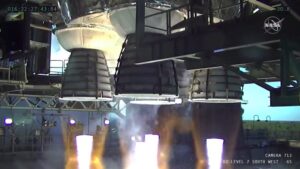19 statement, NASA said the hydraulic system for Engine 2 on the core stage “exceeded the pre-set test limits that had been established” for the Green Run test. “As they were programmed to do, the flight computers automatically ended the test.”
That hydraulic system is part of a thrust vector control system used to gimbal the engine to direct its thrust, and is powered by what NASA calls a Core Stage Auxiliary Power Unit, or CAPU. One CAPU shut down during a gimbaling test that was part of the static fire.
“This gimbaling test event that resulted in shutting down the CAPU was an intentionally stressing case for the system that was intended to exercise the capabilities of the system,” NASA stated. Had such an event happened in flight, the SLS would have used other CAPUs to power the thrust vector control system.
The hydraulic system problem was not linked to a major component failure (MCF) reported by test controllers about 45 seconds after ignition. NASA said the MCF actually took place 1.5 seconds after ignition, and was caused by the loss of “one leg of redundancy” in instrumentation for Engine 4. “Test constraints for hot fire were set up to allow the test to proceed with this condition, because the engine control system still has sufficient redundancy to ensure safe engine operation during the test,” the agency stated.
NASA is still investigating what officials said shortly after the test was a “flash” seen in the vicinity of a thermal protection blanket around Engine 4. The blanket showed signs of scorching, but that was expected from standard engine operations, and temperatures in the engine section were normal.
The parameters used for the Green Run test, the agency stated, were “intentionally conservative to ensure the safety of the core stage during the test.” NASA officials previously emphasized they were taking a cautious approach to testing the core stage since it is flight hardware, intended for use on the first SLS launch, Artemis 1.
“We have to remember that the rocket we just tested is the rocket that is going to launch Orion around the Moon,” NASA Administrator Jim Bridenstine said at a briefing after the Jan. 16 test. “When we do this test, there is risk that we cannot take because this is the same vehicle that will fly Orion.”
“Our test parameters demonstrate our safety-first approach and were appropriately conservative. This core stage is a high-value flight article that will return America to deep space,” John Shannon, vice president and SLS program manager at Boeing, said in a company statement about the Green Run test. “Our redline limits were set to achieve data collection without unnecessarily risking the system.”
NASA has not yet decided if it will perform a second hotfire test. In comments before the first test, NASA and Boeing officials said that while the test was scheduled to last for 485 seconds, they would collect most of the data they needed after 250 seconds. However, the engine shutdown took place after just 67.2 seconds.
Bridenstine suggested in the post-test briefing that it might be possible to move ahead with Artemis 1 launch preparations without a second hotfire test. “I think it very well could be that it’s something that’s easily fixable and we can feel confident going down to the Cape and staying on schedule,” he said. That schedule called for shipping the core stage to the Kennedy Space Center in February for preparations for a launch late this year.
One former NASA official recommended the agency conduct a second hotfire test. “My advice would be to retest and get complete data – may be a couple of weeks but schedule is secondary,” tweeted Wayne Hale, former shuttle program manager and current chairman of the NASA Advisory Council’s Human Exploration and Operations Committee.
John Honeycutt, SLS program manager at NASA, said at the post-test briefing that it would take between 21 and 30 days to prepare for a second hotfire test, assuming no major repairs of or other maintenance on the core stage was needed.



